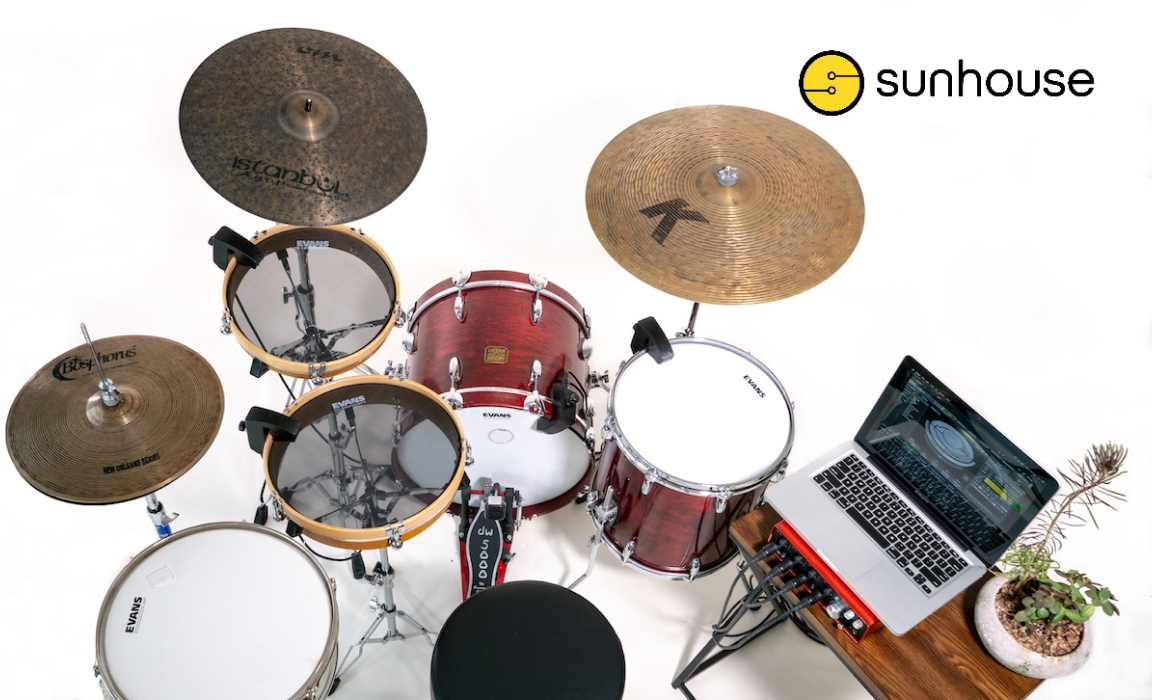The music industry has changed a lot in the last fifty years: from Disco in the 70s, Pop Rock in the 80s, House in the 90s, to Hip-Hop in the 2000s. As someone who grew up in the 2000s, I’ve been exposed to Pop and Hip-Hop all my life. But there’s something in common between The Eminem Show and Donda – they’re “studio” music. Studio Music is defined as music recorded in studios, often with characteristics like synthesized sounds and electronic beats. With the rise of Studio Music in recent years, Acoustic Music – music that primarily uses instruments that produce sound through acoustic means – has been declining in popularity.
Tlacael Esparza, CTO and Cofounder of Sunhouse, has been an Acoustic Musician his whole life. Originally from Los Angelos, Tlacael played piano at a very young age. He then started playing percussion and has been an ardent drummer ever since. Tlacael even went to an arts high school where he studied Jazz, and his love for Jazz took him to New York City, where he pursued an undergraduate degree in Music and Math at Columbia University. After graduating, Tlacael toured around and made records while also having some day jobs, living his life as a musician. That’s when he decided to pursue a Master’s in Music Technology at NYU’s Steinhardt.
At NYU, Tlacael was able to combine his mathematical skills with his musical abilities. “[I] figured out how to connect math and music,” Tlacael describes, “and taking a more applied approach and learning how to program, and learning about machine learning and music information retrieval…. That’s when I got hooked.” That’s also when Tlacael had the idea for Sunhouse, his technology company that uses AI and hardware to empower musicians.
This was around 2014, when the music industry was changing a lot. “From the late 70s, but really the 80s on, starting with drum machines and electronic instruments like sequencers,” recalls Tlacael, “but really picking up in the 2000s with more powerful computers and DAW (Digital Audio Workstation) softwares, things really changed to people being able to make entire records with a computer, without actually needing to touch an instrument.” The music industry transformed into a purely studio art, and Tlacael felt like musicians were shifting from creative driving forces to freelance hires for covers of what producers made or for live performances – they were in the music writing process less and less. Tlacael explained his struggle: “The place where it hit hard was playing drums and… that being my creative outlet, and hearing electronic music and wanting to do that, and then not being able to bridge the two.”
Graduating from NYU with technical expertise and a musical problem, Tlacael went to his brother, Tenoch Esparza, who was studying at Columbia, with the idea of Sunhouse. They applied to the Leslie eLab’s Summer Launchpad program, where they received coaching and some grant money. Tlacael and Tenoch used the grant money to build a prototype, and filed incorporation documents and other logistical things with help from the eLab. “[The program] was very helpful for us to… start think[ing] about actual customers and target markets,” describes Tlacael, “and learn the ropes of what are the kind of things that we’re going to actually have to deal with… when selling a product.”
After the launchpad during summer of 2014, Sunhouse launched a Kickstarter campaign in the summer of 2015. With success from the campaign, Sunhouse shipped its first product in the summer of 2016. For two years after the first shipment, Tlacael worked hard to finetune the product – a missing glue on the hardware here, a bug in the software there… It was a learning curve. At the same time, Sunhouse was consistently listening to customer feedback and adding new features. “The product really changed because of the ways our users were using it,” says Tlacael, “…[the customers] showed us this is not just an electronic drumming product, this is a music making product.”
Flash forward to today, Sunhouse’s Sensory Percussion is an acoustic sensor that users can attach to their drums. The sensor reads the movement of the drumhead and feeds the data into the computer, where the software analyzes the audio stream. Using machine learning, the audio is taken apart into a very simple, symbolic language. “We can tell based on sonic fingerprinting… where you [hit the drum] in a continuous way,” Tlacael explains, “…you can hit a drum in a lot of different ways, there’s all these different techniques, so it’s this high dimensional spatial map.” Because hitting a drum is intuitive, the drummer can install command controls for each strike of the drumstick and basically do everything a computer does. “Essentially you can turn the drums into a really advanced control surface,” concludes Tlacael. Sunhouse users are using the Sensory Percussion in a lot of different ways. College students might clip the sensor onto mesh drum heads, and use the software to experience all the nuances of a drumset without bothering others. Producers might use the sensor to make full records with the drumset, in turn avoiding having to learn the complicated DAW softwares. Performers might use the sensor to program a set such that each time the bass is hit, a light flashes, which makes the show a lot more interactive. The possibilities are endless.
Even with a great product, Sunhouse still faces many challenges. First, being both a hardware and a software company, Sunhouse has a hard time scaling quickly. Due to the nature of hardware, scaling means high costs and in turn, high funding. However, VCs don’t usually get into the Music-Instrument Making industry because of its limited number of target customers and the high cost of hardware. Therefore, Sunhouse has to grow organically. Second, since the COVID-19 pandemic, the world electric chip shortage has really affected Sunhouse’s supply chain. It’s costed Sunhouse delays in shipping, troubles with sourcing, and higher costs from suppliers.
Despite these challenges, Sunhouse is pushing forward. Sunhouse is working on a long-awaited second product, and Tlacael says having that first experience with building, launching, and selling a product is very helpful. Sunhouse’s goal is to disrupt the relationship between music and technology. Right now, technology must be learned to make music: musicians who want to produce have to learn to operate a big mechanical mixing board with countless buttons in order to do something that they know how to do intuitively. Sunhouse is trying to reverse that relationship: musicians can use their musical skills to design software around musical ideas. This will empower musicians and give them more room to innovate. Much like how the technological innovation of electric guitars gave birth to Rock and Roll, Sunhouse’s technological innovation might just lead to the next big thing in music.

